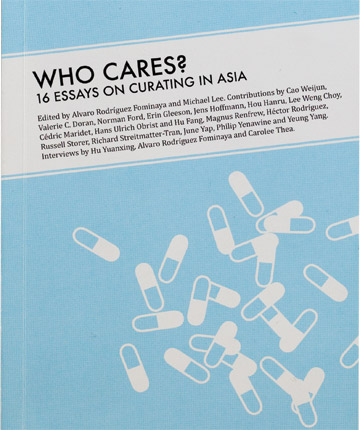CURATING IN ASIA
| February 22, 2011 | Post In LEAP 7
We find in Hong Kong something of a curatorial anxiety: there are very few makers of exhibitions active in the local art scene, and, though this is entirely in keeping with the small scale and number of available exhibition spaces, intimate connections between institutional academic research and critical writing in the territory lead to a general sensation of lack in this regard. It is fitting, then, that the leading nonprofit art space in South China, Para/Site, should team up with the omnipresent Jockey Club Charities Trust for a curatorial training course purporting to link international curators and writers with emerging local practitioners. This publication represents an outcome of that venture (perhaps more productive than the concluding exhibition), collecting essays on the state of curating in Asia by instructors and others involved. Taking advantage of the position of Hong Kong within an English-language discourse of international art in a Chinese context, this could be a fascinating project for exhibition practice across greater China.

A broad range of ideas are introduced here, many familiar but some, on occasion, quite novel. We read of the shock of the European curator operating in China for the first time, as Alvaro Rodriguez Fominaya describes how curators function as agents and alternative spaces as galleries. Singaporean artist Michael Lee outlines a range of roles, from art direction and publicity to administration and writing. Lee Weng Choy speaks of wonder. Most interestingly, Jans Hoffmann calls for a return to experimentation within the space of the gallery space rather than beyond it, a conservative notion that has become a minority position. Some of the more valuable perspectives here come from unexpected angles: artist Cedric Maridet writes on the necessity of an amateur approach to context-specificity in the sphere of sound installation, while art fair director Magnus Renfrew warns curators against becoming the ultimate consumers in the pursuit of the new.
The most striking summary of the publication can be found within the brief description on the rear cover: “… these texts constitute primary notes towards ‘curatorial criticism,’ a subfield of cultural criticism that identifies the new in curating today.” This self-conscious positioning of the work as explicitly “curatorial criticism” rings true with the tone of virtually all of the essays included: the close reader will find banished from these pages any lingering aroma of the modernist idea of the heroic critic as an author of a certain literature in her own right, replaced with the cold and scripted discourse production of curatorial writing. Many of us working in these fields today may harbor sympathies for both ideologies of the pen, but it would appear that the time for a definitive choice between textual production and word craft may be close at hand.

